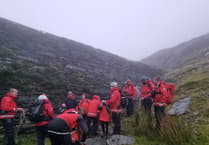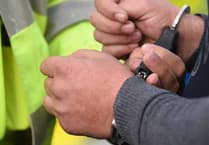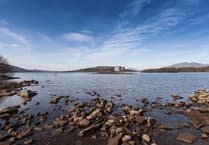Penygroes residents have come together to celebrate the installation of new sculptures marking the village's connection to the slate industry.
Artist Angharad Pearce Jones was commissioned by Gwynedd Council to create the sculptures as part of the Llewyrch o'r Llechi project, a UK Government funded cultural investment programme linked to The Slate Landscape of Northwest Wales World Heritage Site.
Angharad worked with pupils from Ysgol Bro Lleu and Ysgol Dyffryn Nantlle, as well as local historians and community groups to learn more about the slate industry, and to create the designs.
A number of the pupils and members of community groups attended an event in March to celebrate and take pride in the fact that the artwork is now in place.
The unique artwork is based on the original method of transporting slate from the depths of the Dyffryn Nantlle quarries to higher ground, a system made up of ropes, wires and wheels, called Blondins.
The two pieces measure almost four meters high each and are made of corten steel.
They are located near Byw'n Iach, Plas Silyn.
Angharad said: "It's been exciting to work on one of the public art commissions in the Slate Landscape of Northwest Wales.
"It's been great to work with the young people of Penygroes, to develop a piece of art that reflects the remarkable post-industrial landscape of Dyffryn Nantlle and the strong literary culture of this special area."
Historian Dilwyn Williams added: "It's been a privilege to walk around with Angharad, to show Dorothea and the remains of the old quarries, and to discuss the Blondin system, which carried the slate up. The Blondins, I'm proud to say, are the inspiration for the sculptures."
Blondins are a ropeway system used in quarries and other industrial sites, originally invented in Scotland, where a passenger vehicle was driven along a chain-link line and from where a conveyor rope was controlled separately. It was named after the famous rope walker, Charles Blondin.
Cllr Craig ab Iago, local member for Penygroes and Gwynedd Council Cabinet Member for Environment, said: "This is a good example of the positive attitude in this area, where there are a number of great innovative projects taking place. What we're doing today celebrates the past, and the UNESCO status is a very important part of that.
"I hope projects like this will lead to more things that keep us connected to our history."
Also present at the event was Llanllyfni Community Councillor, Justin Davies, who has been interested in area’s slate history since he was a child.
Justin said: "It's really nice to see the sculptures in place, and it's important that our history is celebrated, and the children learn about it.
"With a project like this, it's an opportunity for the school to get involved, and their contribution will be something for the children to remember."
The work would not have been possible without the support of Byw'n Iach and Cyngor Cymuned Llanllyfni Community Council, who helped develop the concepts, and who have taken ownership of the sculptures.
.jpeg?trim=0,0,0,0&width=752&height=501&crop=752:501)




Comments
This article has no comments yet. Be the first to leave a comment.